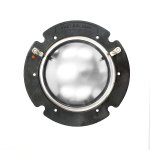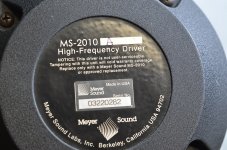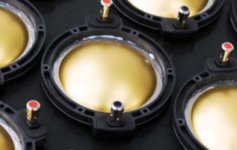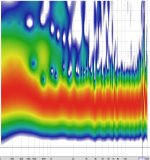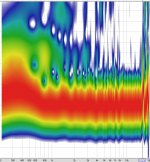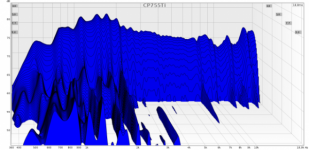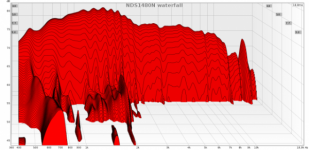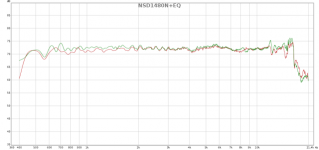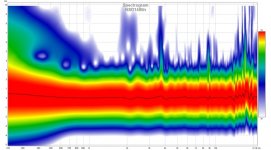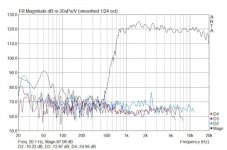My subjective observations are roughly the same as Dr. Voishvillo's remarks,
I know Alex well, and that is not the position that he takes in private. But at any rate a one line sentence is hardly comparable to a six month study.
Further, I am not sure what "nonlinearity of breakup modes" means.
I know Alex well, and that is not the position that he takes in private. But at any rate a one line sentence is hardly comparable to a six month study.
Further, I am not sure what "nonlinearity of breakup modes" means.
I don’t know exactly how much I can quote from the AES papers, but I hope that I do not infringe copyright.
One of the methods to increase the level of high
frequency signal in horn drivers is to use the full-metal
(typically titanium) dome diaphragm and surround
(typically having a “diamond” or a “tangential” three-
dimensional pattern). This combination is characterized
by the high-frequency resonances (breakups) that
produce “boost” of the high-frequency response level.
However, this “amplified” high-frequency response is
characterized by severe irregularity, i.e. by the sharp
peaks and dips that will be evidenced in the frequency
response. In addition, due to the nonlinear nature of
these high-frequency resonances, their existence is
accompanied by a strong nonlinear behavior. In the case
of the input sinusoidal signal, this particular nonlinearity
generates high harmonic distortion and, to make matters
worse, it also generates subharmonics whose level may
easily equal or even exceed the level of the fundamental
input tone. In the presence of musical or speech signals
the nonlinearity associated with the breakup modes
adversely affects subjective sound quality and manifests
itself in the form of harshness of the reproduced sound
that may be very irritating to the listener.
It seems very strange to me if the public and private statements of Dr. Voishvillo differ. If only because public statements seem reasoned enough.
Actually, I was too impressed with MS-2010, so I don’t remember how good it was. It may seem unexpected, but I was also impressed by Beyma's 755 driver (bearing in mind its price) 🙂.
It's not unexpected at all, because both the Beyma and 18Sound are on top of my list.
No doubt about the quality of the MS-2010, which is manufactured by Radian.
The Aluminium replacement diaphragm will set you back > $500.
Attachments
Last edited:
Be with Bee wax at this price...
modern "plastic" diags are certainly good enough for hifi uses (and smoother perhaps).
modern "plastic" diags are certainly good enough for hifi uses (and smoother perhaps).
Last edited:
The actual mic is CEL-192/2F (200V polarized, 3% of THD reaches at 146dB, but I have also RFT mk301, MK202, pair of CEL-186/2R...), preamp is rft-gefell mv201, the amp - MC2 650, analyzer - emu 0404 usb +REW.
Funny that you also use the EMU 0404 (Mk1 or 2?). I bought one last year in like new condition for only €10 and was amazed about its performance, considering it's almost vintage by now.
Dmitrij, do you remember whether the Beyma was the 755 Ti(tanium), or Al(uminium) version?
It was Ti.
Funny that you also use the EMU 0404 (Mk1 or 2?). I bought one last year in like new condition for only €10 and was amazed about its performance, considering it's almost vintage by now.
I don't know which version I have (mine is gray). I bought the card in 2012 for measurements. What is difference between mk1 and mk2 ? Probably mk2 is white ?
It's not unexpected at all, because both the Beyma and 18Sound are on top of my list.
No doubt about the quality of the MS-2010, which is manufactured by Radian.
The Aluminium replacement diaphragm will set you back > $500.
I read on some forums that the earlier driver models were actually produced by the radian, but the ms-2010, as far as I know, is produced by Meyer Sound. 🙂
Perhaps MS assembles the parts inhouse, which are obviously different from the regular Radian drivers.
The diaphragms however, are definitely made by Radian.
One of the reasons why you liked both the Meyer and the Beyma may - at least partly - be related to the Mylar suspension of the diaphragms.
The diaphragms however, are definitely made by Radian.
One of the reasons why you liked both the Meyer and the Beyma may - at least partly - be related to the Mylar suspension of the diaphragms.
This is also my concern regarding the NSD 1480N, which is the driver I referred to in post #2330.
Despite the Tin coating, the diaphragm is still all-Titanium instead of an assembly composed of a (Nitride coated) Titanium dome sandwiched to a polyester suspension unit.
Despite the Tin coating, the diaphragm is still all-Titanium instead of an assembly composed of a (Nitride coated) Titanium dome sandwiched to a polyester suspension unit.
Attachments
...Is this 18thSounds not needing a strong EQ above 15k hz... the 755 ti is better in highs till 20 khz ? At the oppoit the nsd 1480n can be Xoed lower than the 455 ti from what I read.
FaitalPRO | HF Drivers | HF1440 ?
well all is about the horn that can be drawn, I assume as all the good work you all make here is abut to avoid the most possible EQ and still work low : circa 800 hz ... up to 18/20 k hz when all of you talk about the drivers ?
I liked once what Earl Gedles said about the compression drivers and drivers : they are "simple" commodities 🙂 ! Never understood if it was pun intented somewhere 😀
sorry, for the disgress. Very fascinating thread, still have to understand and read more the other thread in order to understand how to swap the drawings by a real constructed horn😀. Continue the good work, many thanks all for that 🙂
FaitalPRO | HF Drivers | HF1440 ?
well all is about the horn that can be drawn, I assume as all the good work you all make here is abut to avoid the most possible EQ and still work low : circa 800 hz ... up to 18/20 k hz when all of you talk about the drivers ?
I liked once what Earl Gedles said about the compression drivers and drivers : they are "simple" commodities 🙂 ! Never understood if it was pun intented somewhere 😀
sorry, for the disgress. Very fascinating thread, still have to understand and read more the other thread in order to understand how to swap the drawings by a real constructed horn😀. Continue the good work, many thanks all for that 🙂
What does it matter?
I was about to buy a pair of NSD1480Ns for about 75% of the price of a single Beyma CP755Nd/Ti.
In France the NSD has been favoured by a number of people.
In France directivity is not of primary importance, JMLC and Salmon horn types rule the forums. The NSD is popular in combination with Arai/TAD and similar radial horn types. With these horns the drivers are supposed to be good from about 450-500Hz.
We should consider the falling response in the top octave of the 18 sound drivers if we plan to use them with ATH4.
I am not so sure about the suitability.
Some (badly scaled) spectrograms, from left to right: 18Sound ND2080, ND2080 A(luminium), ND2080 N(itride).
I was about to buy a pair of NSD1480Ns for about 75% of the price of a single Beyma CP755Nd/Ti.
In France the NSD has been favoured by a number of people.
In France directivity is not of primary importance, JMLC and Salmon horn types rule the forums. The NSD is popular in combination with Arai/TAD and similar radial horn types. With these horns the drivers are supposed to be good from about 450-500Hz.
We should consider the falling response in the top octave of the 18 sound drivers if we plan to use them with ATH4.
I am not so sure about the suitability.
Some (badly scaled) spectrograms, from left to right: 18Sound ND2080, ND2080 A(luminium), ND2080 N(itride).
Attachments
Last edited:
I think in France they seem ruled by the TAD (Urei) profil horn... and Onkens cabinets.
Did you publish in France ?
Did you publish in France ?
Indeed, it's the legacy of J. Hiraga and others.
I don't publish there, I only steal from the French.
I don't publish there, I only steal from the French.
You know the joke, the tunnel was closed because of a camembert shippment in a truck that melt ! No more dirictivity Index !
A comparison between the Beyma CP755Ti (blue) and the NSD1480N with the XT1464.
The CP755Ti is the ferro magnet version of the 755 and half the price of the NSD1480N.
The CP755Ti is the ferro magnet version of the 755 and half the price of the NSD1480N.
Attachments
Last edited:
A comparison between the Beyma CP755Ti (blue) and the NSD1480N with the XT1464.
Which one is which?
And something ridiculous: the Beyma CP380M with the tiny RCF H100, high-passed at 600Hz.
Attachments
Last edited:
Wow, those distortion levels are pretty unbelievable. What's the reference level?And something ridiculous: the Beyma CP380M with the tiny RCF H100, high-passed at 600Hz.
Famous from 30 years this Beyma 🙂 , remove the 2.5 to 4k nasty (flat it) and that's a musical cd according many... halas needs a 3 way system.
I stolen that for the one interrested by the distors.Grand Comparatif de Compressions 1 pouce - JustDIYIt !
I stolen that for the one interrested by the distors.Grand Comparatif de Compressions 1 pouce - JustDIYIt !
- Home
- Loudspeakers
- Multi-Way
- Acoustic Horn Design – The Easy Way (Ath4)
